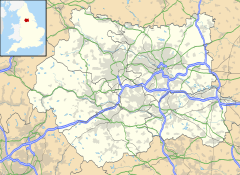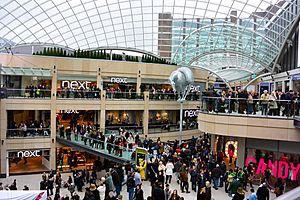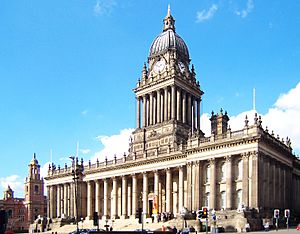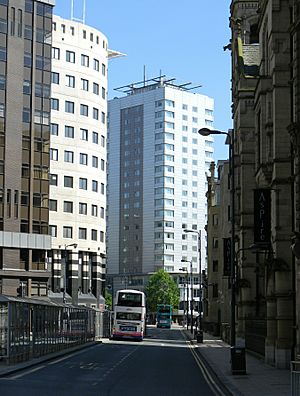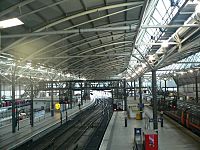Leeds city centre facts for kids
Quick facts for kids Leeds city centre |
|
|---|---|
 A view of the south side of Leeds city centre, from Beeston Hill in February 2013 |
|
 Street map |
|
| OS grid reference | SE297338 |
| • London | 190 mi (310 km) SSE |
| Metropolitan borough | |
| Metropolitan county | |
| Region | |
| Country | England |
| Sovereign state | United Kingdom |
| Post town | LEEDS |
| Postcode district | LS1, LS2, LS10, LS11 |
| Dialling code | 0113 |
| Police | West Yorkshire |
| Fire | West Yorkshire |
| Ambulance | Yorkshire |
| EU Parliament | Yorkshire and the Humber |
| UK Parliament |
|
Leeds city centre is the main part of Leeds, a big city in West Yorkshire, England. It's like the heart of the city, where lots of businesses and shops are. The city centre is mostly surrounded by the Leeds Inner Ring Road to the north and the River Aire to the south. It's split into different areas, each with its own special feel.
Contents
Exploring Leeds City Centre
The Historic Heart: Under The Headrow
This area is known as the old town and is the main shopping hub of Leeds. It stretches south from The Headrow all the way to the River Aire. Kirkgate and Briggate are the oldest streets in Leeds, where the city first began to grow. Briggate is now a street just for people walking, filled with many popular shops and food places.
The old town has several smaller sections. These include the city square, beautiful Victorian shopping arcades like the Grand Arcade, and large department stores. You'll also find indoor shopping centres such as The Light and St John's Centre. Near The Calls, you can explore markets like the Corn Exchange and Leeds Kirkgate Market.
Trinity Leeds is a huge shopping centre that opened on March 21, 2013. On its first day, an amazing 130,000 people visited! This project cost £350 million and created 3,000 jobs, making it a very important development for Leeds. It was the only big new shopping centre to open in the UK that year. Trinity Leeds has space for 120 shops and many smaller, temporary "pop-up" shops.
The Calls area is located close to the River Aire. This area used to be industrial, but it changed a lot from 1985 to 1995. Old warehouses were carefully turned into modern flats and businesses. Today, many of these historic buildings are now homes and offices.
North of The Headrow: Entertainment and Civic Buildings
In the past, the city of Leeds ended at The Headrow. North of this street, many entertainment venues and important city buildings were constructed.
This area is home to major entertainment spots like Leeds Arena, Leeds Academy, and the Leeds Grand Theatre and Opera House. Millennium Square was a big project built for the year 2000. It often hosts concerts with famous bands like the Kaiser Chiefs and Fall Out Boy.
You'll also find many grand Victorian buildings here that are important for the city's government. These include Leeds Magistrates' and Crown Courts, Leeds Library, Leeds Art Gallery, Leeds Civic Hall, and Leeds Town Hall. The Town Hall was finished in 1858 and opened by Queen Victoria. Leeds Civic Hall opened in 1933, opened by King George V. It holds the Lord Mayor's office and council meeting rooms. Many lawyers' offices are also found here because they are close to the courts.
This part of the city also has many tall apartment buildings, like Sky Plaza and Opal 3. Altus House is the tallest building in Yorkshire. Other important places include the Yorkshire Bank headquarters and the Merrion Centre. Queen Square is also located in this area.
University and Hospital Campuses
Leeds General Infirmary (a hospital), Leeds Beckett University, and the University of Leeds all have large campuses in the north-east city centre. These campuses stretch across both sides of the inner ring road. There are also smaller schools nearby, such as Leeds Art University, Notre Dame Sixth Form College, Leeds City College, and Blenheim Primary School.
East Side: Culture and History
Quarry Hill is known as the city's northern cultural area. Around Centenary Square, you'll find important buildings like NHS England's Quarry House and the BBC Yorkshire building. The Leeds Playhouse theatre opened here in 1990. Leeds College of Music moved to its current spot in 1997, and Northern Ballet moved here in 2010. Leeds City College also has a large campus in this area.
Leeds Dock is the city's southern cultural area. This is where the Royal Armouries Museum is located. The museum cost £42.5 million to build and took two years to complete. It has become one of Leeds's most popular places for tourists to visit.
West Side: Business and New Developments
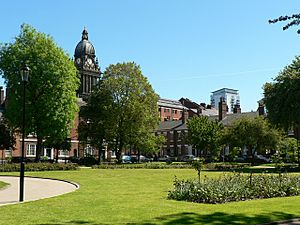
The Financial Quarter is bordered by Park Row to the east, the Leeds Inner Ring Road to the west, The Headrow to the north, and Wellington Street to the south. Its centre is Park Square, a lovely green space in the city centre. Many big companies like Aviva and The Bank of England have offices here. This business area has been growing towards the west of the city. New developments like Wellington Place are bringing in more international companies.
Historically, Holbeck Urban Village was a part of Holbeck closest to the city centre. Now, it's considered part of the city centre itself. It's an area with a mix of homes and businesses, located south of Leeds railway station. Important buildings like Bridgewater Place and Granary Wharf are found here. This area is seen as a great spot for new buildings, partly because a new High Speed 2 train station was planned to be nearby.
Major Companies in Leeds City Centre
Many important companies have offices or headquarters in Leeds city centre.
Financial Companies
- The Bank of England
- Aviva
- Zurich Financial Services
- Leeds Building Society
- Lloyds TSB
- KPMG
- Direct Line
- Yorkshire Bank
- HBOS
Hotels and Restaurants
- Queens Hotel
- Malmaison Hotel
- Radisson Blu Hotel
- The Ivy
- Miller and Carter
Other major companies include the headquarters of Asda and Channel 4.
Leeds Lights
Every Christmas, the streets of Leeds city centre are decorated with many beautiful Christmas lights. There's a special "switch-on" ceremony in early November. A celebrity turns on the lights at Victoria Gardens, and thousands of people come to watch. When the Leeds Lights first started in 1983, the switch-on was later in November, but now it's earlier. These lights are famous for being the biggest display in the United Kingdom. They stretch over 13 miles of city streets and use more than 2 million energy-saving light bulbs.
Leeds is special because it designs, makes, and looks after its own Christmas light decorations. The workshop started to give people with disabilities job opportunities. The workshop has moved a few times and has been in Seacroft since 1993. For many years, Leeds City Council was the only local authority to do this. Now, a few other councils have started making their own displays too, but most still buy their lights from other companies. The lights are fixed and cleaned every year at the Leeds Lights workshop. They store 80,000 coloured lamps and use 2000 meters of coloured rope lights. A team of 14 people works all year to create the display. From October to January, a team of 9 people puts up the lights for the switch-on and then takes them down after Christmas.
Some of the lights, like the champagne bottle lights on The Headrow, are allowed to have advertisements on them.
Here are some celebrities who have turned on the Leeds Christmas lights:
- 2018 – Josh Warrington
- 2017 – Danny McGuire and Rob Burrow
- 2016 – Alistair Brownlee, Jonny Brownlee and Kadeena Cox
- 2015 – Danny McGuire
- 2014 – Sam Bailey and G4
- 2013 – Gabriella Cilmi and The Vamps
- 2012 – Jonathan Brownlee
- 2011 – Matt Cardle
- 2010 – McFly, Shayne Ward
- 2009 – Pixie Lott, Mini Viva, Girls Can't Catch
- 2008 – Leon Jackson, Alesha Dixon, Simon Webbe
- 2007 – Shayne Ward, Dick and Dom, Chico
- 2006 – McFly
- 2005 – Rachel Stevens
- 2004 – Chris Moyles and Girls Aloud
- 2003 – Phill Jupitus
- 2002 – Ainsley Harriott
- 2001 – Vinnie Jones and Lucas Radebe
- 2000 – Mark Lamarr, Dave Benson-Phillips, Harry Kewell, Sheree Murphy and Billie Piper
- 1998 – Mel B and Les Dennis
- 1997 – Rolf Harris and Rod Hull & Emu
- 1996 – Dale Winton
- 1995 – Little and Large, Right Said Fred and PJ and Duncan
- 1994 – Paul Daniels
- 1993 – Noel Edmonds & Mr Blobby
- 1992 – Sonia
- 1989 – Melanie Hill
- 1986 – Native American Joe Sierra
- 1983 – Russ Abbot
Getting Around Leeds City Centre
 |
Woodhouse |  |
||
| Armley | Cross Green | |||
| Holbeck |
Train Travel
Leeds city centre has its own train station, Leeds railway station. This station is one of the busiest outside of London in England. It's managed by Network Rail and offers train services for long distances, regional trips, and local areas.
Air Travel
The city centre is served by Leeds Bradford Airport. This airport is about seven miles north-west of the city centre in Yeadon. You can get to the airport from the city centre using the A1 bus service. The airport has flights to many places in Europe and further away.
Road Network
Traffic that needs to pass through Leeds city centre is directed around it by the Leeds Inner Ring Road. This is like a city motorway that goes around the east, north, and west sides of the city centre. Much of this road goes through tunnels, so you might not even see it when walking around. All major roads leading into Leeds head towards the city centre. The city centre is also connected to the M621 motorway.
Bus Services
A very useful bus service in central Leeds is the LeedsCityBus. This bus runs every few minutes in a circle around the city centre. It stops at major transport hubs, both universities, and the main shopping and business areas. There have been talks about adding another free bus service for new business, fun, and living areas in the southern part of central Leeds.
Leeds city centre has its main bus station on the east side. However, this station is mostly used for buses leaving the City of Leeds and for National Express services. Local First Leeds buses usually stop on the city streets or at smaller bus stops called "bus points." These can be found at Bond Street, Infirmary Street, Leeds railway station, and the Corn Exchange.


